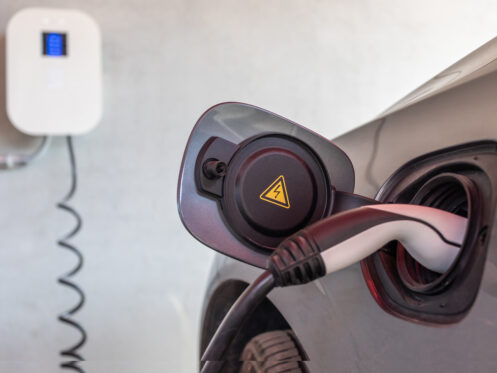If you own a fully electric vehicle or hybrid or are considering purchasing one, where and how you charge it is an important consideration. Using public charging stations can be convenient when you’re out on the road, but there is no doubt that charging your EV at home is more convenient and will cost you much less.
If you’re considering a charging station for your home, here is all you need to know about the different levels of EV charging and why a Level 2 charging station is the best choice.
Level 1 EV Charging
Level 1 is the most basic and slowest type of EV charging. For Level 1 charging, all you have to do is plug your EV into any standard 120-volt outlet. This is an advantage in that you don’t need an actual charging station or any specialized equipment other than the charging cord that came with your vehicle.
The problem with Level 1 charging is that it is painfully slow and will usually only provide around three miles of range for every hour of charging. If your battery was almost completely dead and you plugged your vehicle in overnight while you slept, you’d normally only have around 30 to 40 miles of range the next day. This may be sufficient if you have a short commute, but Level 1 charging isn’t all that practical for most people. Depending on the range of your vehicle, you’d typically need to charge it for 20 to 40 hours to charge an almost fully dead battery.
Level 2 EV Charging
A Level 2 charging station requires a dedicated 240-volt circuit. Although some Level 2 stations can be plugged into the same type of 240-volt outlet that your clothes dryer uses, you’ll generally always get better results if the charging station is hardwired directly into the circuit.
Level 2 charging is much faster than Level 1 and will usually provide anywhere from around 15 to 30 miles of range for each hour the vehicle is plugged in. This means you’ll typically be able to fully charge your battery overnight. The only exception is if you have an EV with a much longer range and your battery is almost completely dead when you plug your vehicle in.
You could potentially even fully charge two EVs every day as long as you never let the battery run too low. All you’d need to do is plug the first one in when you get back from work and then switch over to the second one before going to bed.
One thing to understand about Level 2 charging is that it doesn’t always charge at the same rate. All EVs have a regulator that controls the amount of power that flows to the battery. As the battery starts nearing around 80% charge, the rate of charging greatly decreases. In fact, the rate decreases so much that it usually takes just as long to charge an EV battery from 80% to full as it does to charge a completely dead battery up to 80%. If the rate of charging didn’t decrease, it would lead to the battery becoming much hotter, which could reduce its lifespan and efficiency.
Level 3 DC Fast Charging
Level 3 DC fast charging is what you’ll typically find at most public charging stations. The advantage of Level 3 charging is that it is extremely fast and will typically be able to fully charge an EV in an hour. This is great if you’re planning on taking a long road trip or you suddenly find that your battery is running low and you don’t have sufficient range to get back home.
Most Level 3 charging stations supply somewhere between 50 and 350 kilowatts of power. This means that a Level 3 charging station isn’t an option for your home since this is far more power than a residential electrical system can supply.
Even if it was possible to install a Level 3 charging station in your home, it wouldn’t be a good idea. The reason is that charging your vehicle much faster will cause its battery to degrade much more quickly than if you only use Level 1 or Level 2 charging. If you use a Level 3 charging station too often, your vehicle’s range can quickly start to decrease, and you’ll likely need to replace the battery much sooner. This is why most EV experts recommend you never use Level 3 charging more than three to four times a month if possible.
One thing to note is that Level 3 charging works differently than Level 1 or Level 2. All EVs have a built-in charger, and Level 1 and 2 charging sends power to this charger. The outlet or charging station supplies AC power to the vehicle’s charger, which then converts it to DC power that it uses to charge the battery. This helps to protect the battery by preventing it from getting too hot. Level 3 charging bypasses the EV’s charger and sends DC power directly to the battery, which causes it to get much hotter. This is why using Level 3 charging too often harms the battery.
Benefits of Installing a Level 2 EV Charging Station at Your Home
Installing a Level 2 EV charging station at your home will provide many great benefits. For one thing, having a Level 2 station is extremely convenient and will allow you to always be certain that your vehicle has sufficient range for your daily commute.
A Level 2 home charging station can also help save you lots of money in the long run compared to constantly having to use public Level 2 or Level 3 stations. In fact, the amount you’ll save on charging costs can result in a Level 2 charging station essentially paying for itself within just a few years.
The cost of using a public charging station typically ranges anywhere from around 20 to 60 cents per kilowatt, depending on whether it is a Level 2 or Level 3 station. The current average electricity rate in the Oklahoma City area is only around 12 cents, which shows you just how much cheaper it is to charge your EV at home. While you’d pay the same rate for using either Level 1 or Level 2 charging at your home, Level 2 is definitely the superior choice since it is so much faster.
Another thing to consider is that installing a Level 2 charging station may increase the value of your home by at least what you paid for it. According to the US Department of Energy, homes with Level 2 charging stations typically sell for around 1-3% more than similar homes that don’t have them. If you decide to sell your house within the next five to 10 years, having a Level 2 charging station can also make your home more appealing to some prospective buyers.
As the top home service provider in Norman and the OKC Metro area, Norman Air is the one to trust for EV charging installation and all of your other residential electrical needs. We also offer a full range of plumbing, heating, and air conditioning services. For more information on your options for home EV charging, give our expert team a call today.

